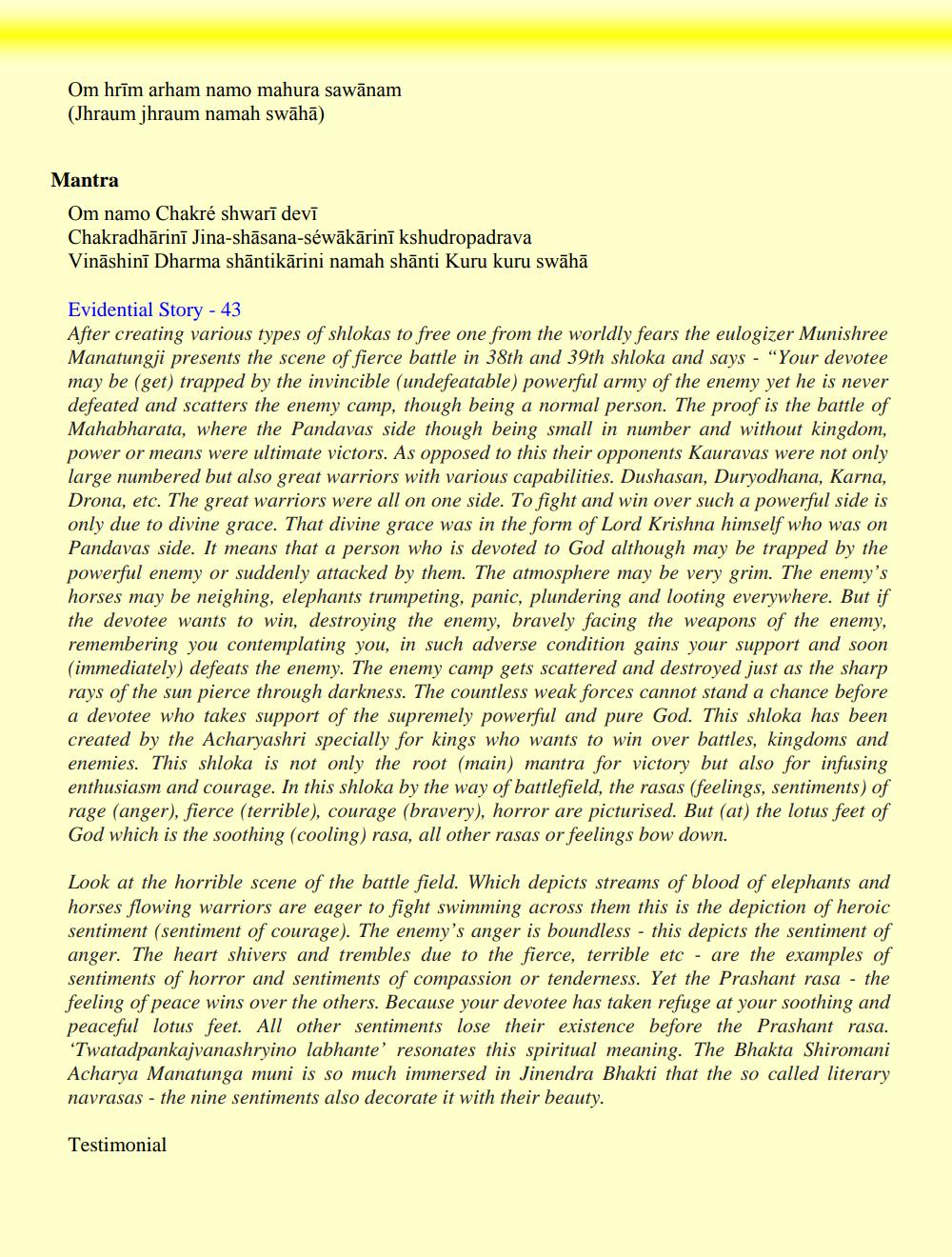________________
Om hrim arham namo mahura sawānam
(Jhraum jhraum namah swāhā)
Mantra
Om namo Chakré shwarī devī
Chakradharini Jina-shäsana-séwäkärinī kshudropadrava
Vinǎshini Dharma shäntikärini namah shanti Kuru kuru swähā
Evidential Story - 43
After creating various types of shlokas to free one from the worldly fears the eulogizer Munishree Manatungji presents the scene of fierce battle in 38th and 39th shloka and says "Your devotee may be (get) trapped by the invincible (undefeatable) powerful army of the enemy yet he is never defeated and scatters the enemy camp, though being a normal person. The proof is the battle of Mahabharata, where the Pandavas side though being small in number and without kingdom, power or means were ultimate victors. As opposed to this their opponents Kauravas were not only large numbered but also great warriors with various capabilities. Dushasan, Duryodhana, Karna, Drona, etc. The great warriors were all on one side. To fight and win over such a powerful side is only due to divine grace. That divine grace was in the form of Lord Krishna himself who was on Pandavas side. It means that a person who is devoted to God although may be trapped by the powerful enemy or suddenly attacked by them. The atmosphere may be very grim. The enemy's horses may be neighing, elephants trumpeting, panic, plundering and looting everywhere. But if the devotee wants to win, destroying the enemy, bravely facing the weapons of the enemy, remembering you contemplating you, in such adverse condition gains your support and soon. (immediately) defeats the enemy. The enemy camp gets scattered and destroyed just as the sharp rays of the sun pierce through darkness. The countless weak forces cannot stand a chance before a devotee who takes support of the supremely powerful and pure God. This shloka has been created by the Acharyashri specially for kings who wants to win over battles, kingdoms and enemies. This shloka is not only the root (main) mantra for victory but also for infusing enthusiasm and courage. In this shloka by the way of battlefield, the rasas (feelings, sentiments) of rage (anger), fierce (terrible), courage (bravery), horror are picturised. But (at) the lotus feet of God which is the soothing (cooling) rasa, all other rasas or feelings bow down.
Look at the horrible scene of the battle field. Which depicts streams of blood of elephants and horses flowing warriors are eager to fight swimming across them this is the depiction of heroic sentiment (sentiment of courage). The enemy's anger is boundless - this depicts the sentiment of anger. The heart shivers and trembles due to the fierce, terrible etc are the examples of sentiments of horror and sentiments of compassion or tenderness. Yet the Prashant rasa the feeling of peace wins over the others. Because your devotee has taken refuge at your soothing and peaceful lotus feet. All other sentiments lose their existence before the Prashant rasa. 'Twatadpankajvanashryino labhante' resonates this spiritual meaning. The Bhakta Shiromani Acharya Manatunga muni is so much immersed in Jinendra Bhakti that the so called literary navrasas - the nine sentiments also decorate it with their beauty.
Testimonial




